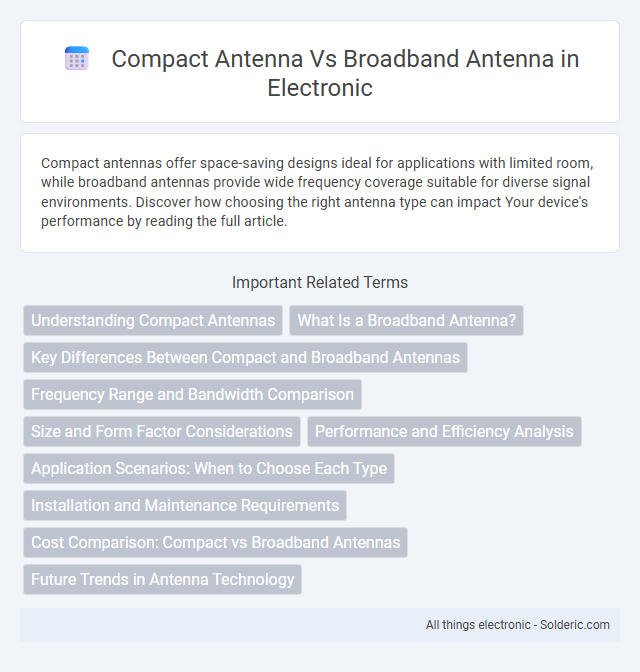Compact antennas offer space-saving designs ideal for applications with limited room, while broadband antennas provide wide frequency coverage suitable for diverse signal environments. Discover how choosing the right antenna type can impact Your device's performance by reading the full article.
Comparison Table
| Feature | Compact Antenna | Broadband Antenna |
|---|---|---|
| Size | Small, space-saving design | Larger, accommodates wide frequencies |
| Frequency Range | Narrow to moderate bandwidth | Wide frequency coverage |
| Performance | Optimized for specific frequency | Consistent performance across bands |
| Applications | Mobile devices, IoT, space-limited use | TV, radar, communications with multiple bands |
| Cost | Generally lower | Typically higher |
| Complexity | Simpler design and implementation | More complex design due to bandwidth |
Understanding Compact Antennas
Compact antennas are designed to occupy minimal physical space while maintaining efficient performance, making them ideal for portable and space-constrained devices. These antennas typically operate within a narrow frequency range and utilize specialized materials or designs to reduce size without significantly compromising signal quality. Understanding compact antennas involves analyzing factors such as antenna efficiency, bandwidth limitations, and the trade-offs between size reduction and frequency performance.
What Is a Broadband Antenna?
A broadband antenna is designed to operate efficiently over a wide range of frequencies, providing consistent performance across multiple bands. Unlike compact antennas that focus on minimizing size often at the expense of bandwidth, broadband antennas prioritize wide frequency coverage for applications like television, radar, and communication systems. Your choice of a broadband antenna ensures versatility and stable signal quality when dealing with diverse signal environments.
Key Differences Between Compact and Broadband Antennas
Compact antennas are designed for size efficiency, offering limited frequency ranges and optimized performance in specific bands, making them ideal for devices with space constraints. Broadband antennas provide wide frequency coverage, enabling consistent signal reception over multiple bands, which suits applications requiring versatility and adaptability. Your choice depends on whether you prioritize space-saving design with focused frequencies or broader frequency adaptability.
Frequency Range and Bandwidth Comparison
Compact antennas typically operate within a narrower frequency range, offering limited bandwidth suited for specific, targeted applications. Broadband antennas provide a much wider frequency range and enhanced bandwidth, enabling effective performance across multiple frequency bands and diverse communication standards. Your choice depends on whether broad frequency coverage or size and simplicity are the primary priorities.
Size and Form Factor Considerations
Compact antennas offer significantly smaller size and flexible form factors, making them ideal for space-constrained applications such as wearable devices and IoT sensors. Broadband antennas require larger physical dimensions to maintain wide frequency coverage, impacting design choices where space is limited. Your device's available space and intended frequency range directly influence the optimal antenna size and form factor selection.
Performance and Efficiency Analysis
Compact antennas typically offer limited bandwidth but excel in space-constrained applications by focusing energy efficiently within a narrow frequency range, achieving good performance in terms of gain and radiation efficiency for specific frequencies. Broadband antennas, designed to operate efficiently over a wide frequency range, provide consistent impedance matching and stable radiation patterns, resulting in higher versatility and better performance in multi-frequency environments. Efficiency in broadband antennas may slightly decrease due to the wider operational spectrum, whereas compact antennas maintain higher efficiency at their designated frequencies but lack flexibility across diverse bands.
Application Scenarios: When to Choose Each Type
Compact antennas are ideal for applications where space constraints and portability are critical, such as in wearable devices, mobile communication gadgets, and IoT sensors. Broadband antennas excel in scenarios requiring wide frequency range coverage and stable performance, including advanced radar systems, multi-band communication networks, and aerospace applications. Your choice depends on whether minimizing size or maximizing frequency versatility is the priority for your specific use case.
Installation and Maintenance Requirements
Compact antennas typically require simpler installation due to their smaller size and lighter weight, making them easier to mount in tight spaces and reducing labor costs. Broadband antennas, while offering wider frequency coverage, often demand more complex setup procedures and regular tuning to maintain optimal performance across the entire spectrum. Your maintenance routine will be more straightforward with a compact antenna, whereas broadband antennas may require frequent inspections and calibrations to ensure reliable operation.
Cost Comparison: Compact vs Broadband Antennas
Compact antennas typically incur lower manufacturing and installation costs due to their smaller size and simpler design requirements. Broadband antennas, designed to operate over a wide range of frequencies, often involve higher material and engineering expenses to ensure consistent performance across bands. Cost efficiency should be evaluated alongside application needs, as broadband antennas offer versatility that can offset their initial higher investment in long-term multi-frequency deployments.
Future Trends in Antenna Technology
Future trends in antenna technology emphasize increased integration of compact antennas for miniaturized devices and broadband antennas for versatile frequency coverage. Advances in materials science and metamaterials enable compact antennas to achieve higher efficiency and gain despite smaller sizes. Your communication systems will benefit from smart antennas that adaptively switch between compact and broadband modes, optimizing performance across emerging 5G and IoT networks.
compact antenna vs broadband antenna Infographic

 solderic.com
solderic.com